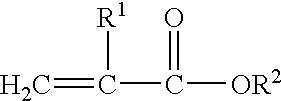Water-in-oil emulsions with ethylene oxide groups, compositions, and methods
a technology of ethylene oxide and water in oil, applied in the field of waterinoil emulsions, can solve the problems of low ph stability of water-in-oil emulsions, product enhancing ability, and product not allowing or enhancing the ability of adhesive products,
- Summary
- Abstract
- Description
- Claims
- Application Information
AI Technical Summary
Benefits of technology
Problems solved by technology
Method used
Image
Examples
examples
[0088]The objects, features, and advantages of the present invention illustrated in the following examples, which incorporate particular materials and amounts, should not be construed to unduly limit this invention. All materials are commercially available unless otherwise stated or apparent. All parts, percentages, ratios, etc., in the examples are by weight unless otherwise indicated.
Glossary
[0089]IOA Isooctyl Acrylate[0090]SMA Stearyl Methacrylate (Rocryl 330, Rohm and Haas, Philadelphia, Pa.)[0091]LMA Lauryl Methacrylate (Rocryl 320, Rohm and Haas)[0092]PEG475 Poly(ethyleneglycol) Methyl Ether Methacrylate (Sigma-Aldrich, MW approximately 475)[0093]EEEA Ethoxyethoxy Acrylate (SR 256, Sartomer, Exton, Pa.)[0094]PEG300 Poly(ethyleneglycol) Methyl Ether Methacrylate (Sigma-Aldrich, MW approximately 300)[0095]PEG1100 Poly(ethyleneglycol) Methyl Ether Methacrylate (Sigma-Aldrich, MW approximately 1100)[0096]IPP Isopropyl Palmitate (Sigma-Aldrich Fine Chemicals, St. Louis, Mo.)[0097]V...
examples 1 – 29
Examples 1–29
Water-in-Oil Emulsion (Cream) Preparations
Emulsion Preparation A (Examples 1–15)
[0121]A typical preparation of a water-in-oil emulsion (cream formulation) of the present invention is detailed as follows (Preparation A):
[0122]Oil Phase ingredients and Water Phase ingredients are listed in Table 3 and Table 4. The Oil Phase ingredients were placed in a stainless steel beaker and heated on a steam bath at 94° C. with minimal stirring for about 30 minutes at which point the solution was homogenous. The Water Phase ingredients were placed in another stainless steel beaker and heated to 94° C. on a hot plate. With moderate stirring, the Water Phase was added to the Oil Phase over about 15 minutes. With continued stirring, the temperature was maintained at above 93° C. for an additional 15 minutes after which time the resulting solution was allowed to slowly cool. When the solution temperature reached 71° C., dimethicone, 1000 CST skin barrier / protectant (1.3 parts, Dow Cornin...
emulsion preparation b (examples 16 – 26)
Emulsion Preparation B (Examples 16–26)
[0126]Emulsion Preparation B was carried out in the same manner as Preparation A, except that the water phase (See Table 4) contained only water (46.41 parts) and dipropylene glycol (5.39 parts). Therefore, the water phase of Preparation B did not contain any magnesium sulfate heptahydrate.
[0127]Following this Preparation B, stable water-in-oil emulsions (cream formulations) were prepared using polyacrylates M (Example 16), AA through EE (Examples 17–21, respectively), and GG–KK (Examples 22–26, respectively); whereas, polyacrylates D, N, and FF produced emulsions that failed the Emulsion Stability Test.
PUM
| Property | Measurement | Unit |
|---|---|---|
| pH | aaaaa | aaaaa |
| pKa | aaaaa | aaaaa |
| peel angle | aaaaa | aaaaa |
Abstract
Description
Claims
Application Information
 Login to View More
Login to View More - R&D
- Intellectual Property
- Life Sciences
- Materials
- Tech Scout
- Unparalleled Data Quality
- Higher Quality Content
- 60% Fewer Hallucinations
Browse by: Latest US Patents, China's latest patents, Technical Efficacy Thesaurus, Application Domain, Technology Topic, Popular Technical Reports.
© 2025 PatSnap. All rights reserved.Legal|Privacy policy|Modern Slavery Act Transparency Statement|Sitemap|About US| Contact US: help@patsnap.com



